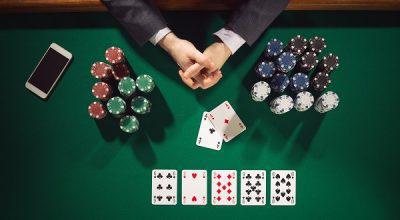Maybe this situation will sound somewhat familiar.
You’re a fan of poker. (Cool, so are we.) After some practice and self-study, you finally got the rules of the game down. (Nice!) But then, very quickly you discovered that there was much, much more to the game than simply remembering how all of the winning hands rank, saying “call,” “check,” or “fold” at all the right moments, or knowing when it’s your turn to be small blind or big blind – without being reminded by the other patient or not-so-patient players. (Good job though. That part’s tough.)
Anyway, you probably realized at some point that if you wanted to win back at least some of your money from your poker buddies, you needed to learn how to bet. So you tackled strategy next – did some research online and read some books, learned the basics of betting and folding, the probability of winning hands, bluffing, etc. then moved on to studying and implementing advanced strategy. It can be difficult to pick all of that up, but you didn’t quit. Congrats!
Even still, you felt that your game wasn’t quite up to snuff. Somewhere along the way, you developed standards that you wanted to reach but couldn’t quite put your finger on what exactly you were looking for. Well, we’re here to say that we’ve got what you need for the next step in your journey. It does get trickier, but the good news is that Slots of Vegas is here to help.
Beyond the basics
Playing poker can be a stressful activity, and it’s time consuming to try and actually improve, which means that it’s definitely not a game for everyone. It doesn’t matter whether you’re just getting into the game or you’ve been playing for years; it’s not a game that makes it easy to keep your cool. You can see this just from doing a quick YouTube search – it will yield clips of the most epic winning hands in poker tournament history, but you’re also just a few clicks away from some equally epic compilations of famous poker player’s impressive meltdowns.
This aspect of improving your skills is all about psychology. You can understand strategy and how to calculate the odds, but what you can’t do is determine what goes on at the table itself. One of the biggest unknown variables will be your opponents. In short, knowing the game will amount to close to nothing if you don’t get to know the people you are playing against.
A big component of implementing optimal strategy is being able to identify the four types of poker players. Why? Two important reasons: you need to know who you’re playing against to interpret why they make the choices they make. After all, you’re trying to figure out what hands have and whether theirs are better than yours. That insight must inform the way you play because how smart a move is will be determined by the types of poker players you’re up against. The second reason is that you’ll also begin identifying your own natural style. Seeing the advantages and disadvantages of each type of player will help you hone your own skills.
How are these poker player types defined?
“If you know the enemy and know yourself, you need not fear the result of a hundred battles. If you know yourself but not the enemy, for every victory gained you will also suffer a defeat. If you know neither the enemy nor yourself, you will succumb in every battle.”
– Sun Tzu, The Art of War
The four established poker playing styles are primarily defined by two factors: starting hand and betting pattern. As you know, a player’s starting hand consists of the two hole cards he has face down in front of him. Don’t get this confused – when we talk about the importance of the starting hand, it’s not about how this person plays the hand; instead, it’s about whether they choose to play it at all or simply to fold.
A loose player is an opponent who plays hands frequently. He doesn’t have particularly strict criteria when it comes to choosing what hands to play – there’s a big range of possibilities. A tight player, as you might guess, does the opposite. Their requirements for a starting hand are stricter, so they play much less frequently and with fewer (and therefore better) starting hands.
Second, you must consider betting pattern. Players are categorized as either passive or aggressive when it comes to bets. An aggressive opponent bets frequently and often places higher bets; the passive opponent bets infrequently and more conservatively.
So let’s move on: what are the four different types of poker players and what do you need to know about them? First up, the loose passive player.
Loose Passive
Definition:
This style of play is distinguished by 1. playing a wider variety of hands than other players do on average, more often than he should, and 2. calling instead of opening with or raising bets (or folding for that matter), more often than he should.
Also Known As:
Calling Station; Fish; Donkey
How to Identify This Player:
Often an unfamiliar face (probably a novice). More commonly found at lower stakes games, where they are able to afford to play poorly and for longer periods of time. Extremely likely to be bad at poker. Talkative, likes to say that he’s playing “just for fun.” Favorite word: call.
Player Characteristics:
Whether it’s because he’s new, stubborn, or just not very smart, a calling station just does. Not. Fold. Who knows, they might have missed that one lesson in Poker 101 where you learn that folding and raising bets are also options. More than anything else, this player cares about seeing the flop, and you can depend on him to stick around just to see how the game unfolds, often regardless of his hand.
The loose passive players seem to have an almost nonexistent grasp of the concept of strategy. As a rule, they do not consider the probability of different outcomes. Attempting to learn how to be a good poker player or identify good hands? That’s a foreign concept. Sometimes these players are in it simply because they think poker is cool. They’re eager to be a part of the action, and that’s fine, because it means you have at least one opponent who doesn’t really know what to do or how to play.
Counterstrategy:
Do NOT try to out-bluff the loose passive player! You will be extremely tempted to, just to wipe that silly grin off his face. But don’t give in because your bluffs will be lost on this kind of player. Being aggressive to meet a Calling Station’s passivity is not going to end well for you. No matter what, bluffing just won’t make the player fold.
This can be frustrating because you do need to wait until you actually have a hand. But be patient. When you do have a decent hand, make a value bet (the desired outcome of which is to get the opponent to call the bet, even though folding is the right move). Be selective while still playing more hands against them than you might against tighter or more aggressive players. You don’t need to have the strongest hand to win because you know he’ll call even if he has a weak one. And when you do have a strong hand, bet aggressively and strategically to take advantage of the opportunity.
Tight Passive
Definition:
This style of play is distinguished by 1. playing a significantly lower frequency of hands than other players, and 2. rarely betting or raising.
Also Known As:
Rock; Weak-tight
How to Identify This Player:
Relatively quiet and not too active in the game. Patient. Doesn’t bet and may seem uncertain and afraid to lose. Wins hands more frequently than the loose passive player; winnings are usually modest because he chooses to match instead of increasing bets, even with good hands.
Player Characteristics:
The tight passive player is biding his time, and everyone else at the table knows it. He’s the most conservative of the four types and doesn’t like taking risks. The advantage to this style is that the player definitely isn’t going to suffer the same steady stream of losing rounds that the calling station might experience.
These players are selective with starting hands, which is a good trait. However, after the flop, they continue with being cautious, even when they might have a decent hand. They tend to check or call instead of betting or raising. The tight passive player is one of the more predictable types. That means that when he does bet, he definitely has something big to look out for.
Unlike loose players, the Rock doesn’t tend to do things without thinking, but that’s also the reason he can’t get ahead of the game – he overthinks and doesn’t want to take risks. Passive players tend to avoid confrontation and with a cautious, risk-averse mindset. There’s a slight distinction to be made between the weak-tight and rock styles. The Rock plays tight before the flop; then, if he has a particularly strong hand, he bets aggressively after. The weak-tight player is less tight and tries to hit the flop, but can sometimes fold if challenged.
Counterstrategy:
This is a predictable opponent. It’s easy to read him. If he folds, that’s great, no further consideration needed. If he checks or calls, his hand is likely not going to be too bad. But, he’s a really easy player to bluff because he’ll back down most of the time. As a general rule, your tactic against him should be to bet and raise bets liberally. And if he raises, too, you know it’s time to fold.
Loose Aggressive
Definition:
This style of play is distinguished by 1. playing a much wider variety of hands than others, and 2. betting on the majority of flops.
Also Known As:
LAG; Maniac
How to Identify This Player:
Aggressive, loud, careless with his money. Bluffs often. Can be intimidating but also can liven up an uneventful game considerably. Unfamiliar with the term “fold.” Outside of poker, you can guess that he’s the kind of person who doesn’t plan for the future or think too much before acting.
Player Characteristics:
This is the opposite of a tight passive player, in his style and sometimes in personality as well. Regardless of what two hole cards he is dealt, he’s in. The flop is almost as inconsequential – he nearly always bets or raises. It’s hard to read him because you can’t predict a pattern when it comes to how his hand affects his choice, and he bluffs often and well. This style of playing can be profitable if you’re among amateur players – the maniac bets aggressively to scare the others off, the opponents fold, and then the player takes down a sizable pot. It’s a high-risk strategy, one that professional players can employ with success, but it’s not recommended for novices.
Counterstrategy:
It can be difficult to determine what kind of hand he has, and it’s generally not a good idea to bluff. His constant pressuring can make it difficult to maintain a clear head, but don’t waste your energy on trying to read him. Here’s the thing: you don’t need to have the strongest hand to beat this player – with his wide range of starting hands, your odds aren’t bad. Continue to play tight pre-flop, but also be aware that you don’t need the strongest hand to win. If you hit the top or second pair on the flop, it’s likely to be enough against this player. And when you do have a big hand, bet strategically to set up a big pot. With this player, it’s especially important not to forget to do two things: 1) stay calm, and 2) remember to manage your bankroll. If you don’t, he can really mess with you.
Tight Aggressive
Definition:
This style of play is distinguished by 1. playing hands less frequently and more selectively than other players, and 2. betting aggressively with strong hands.
Also Known As:
TAG; Shark
How to Identify This Player:
Plays very few hands, might give off the impression that he’s a timid or less active player at first. However, on the hands he does choose to play, you’ll hear a lot of bets and raises. Plays confidently, which can come through either in an exaggerated or understated way.
Player Characteristics:
Without a doubt, the tight aggressive players are the most formidable of adversaries, making up the most successful online poker players and live tournament professionals. They manage to be both patient and aggressive, which is the most profitable approach in the long run. They aren’t afraid to miss out on the action. If it’s not smart to play for a few rounds in a row, they have no problem with sitting them out. They’re selective with their hands, only playing with the best starting hands, and they’re confident in their skills. When you wait for the best cards and play them strongly, these opportunities will pay off. Where the tight passive player misses out on profitable opportunities, the Shark goes in for the kill. When the other players observe his playing style, they tend to fold more easily under pressure.
Counterstrategy:
If you’re up against a Shark, you’ll have to stay alert and play carefully – you can lose a lot if you don’t. Only fully engage when you have strong hands, but don’t allow yourself to be bullied either. If they’re raising and you’re confident in your own hand, don’t back down right away. Before the flop, if a TAG is already betting, folding is the right move, unless you have the one of the very best starting hands (highest pairs). In that case, it makes the most sense to play these hands aggressively. However, if the player goes all-in, you know what that means.
Another method is to simply not participate in games where there are too many tight aggressive players. However, you can’t avoid them completely, so take these moments as lessons on how to be a good poker player yourself. All players have their own different temperaments and natural tendencies. If you really want to improve, it would be wise to take some pointers from the most skilled and successful players.
Another important note
There’s another key element of improving your poker skills, one isn’t only related to building an understanding of the other players. Well, as the famous saying goes, you have to know your enemy, but you also need to know yourself. It’s good to identify your own playing style and try to mix things up so that you aren’t pigeonholed as one type of predictable player. But there’s more, and it has to do with a little something called “tilt.”
If you haven’t already heard of it, the poker term “tilt” is used to describe a specific state of mind. Often brought on by frustration or any other negative emotional response – for example: anger, anxiety, dismay, alarm – this psychological state can affect a competent or even highly skilled player’s ability to make smart decisions. This can happen after an unpredicted loss, during an unlucky streak, or when an opponent is being aggressive or intentionally antagonizing the player. This is one of the most difficult things to deal with. No one is capable of playing entirely without emotions, and all poker players know what it feels like to be on tilt when the game isn’t going their way.
So what about getting off tilt? Inevitably, this will happen to you. It’s guaranteed. You would be wise to prepare for it sooner rather than later. But how, you ask? Start by catching it soon – make it a priority to identify the signs early on. Physical changes like racing pulse or uneven breathing, saying or doing things that seem out of character, blaming others or being hard on yourself, negative thinking – these are just a few signs that you might be on tilt. After you play, it might be helpful to make a few quick notes about what specifically happened and what you noticed in your reactions – internally and externally. That will help you understand what sets you off.
Next, it’s important to develop some go-to strategies for when you’re on tilt, focused on deescalating your mental and emotional state and get you back on track to optimal strategy. That could mean taking a few deep, meditative breaths or some other small mental and physical exercises to help you recalibrate. After calming down a bit, it would also be beneficial to remind yourself that there’s always a lesson to be learned from losing a hand.
All in all, managing your own mental state is just as important to your success as understanding others’. If taking deep breaths doesn’t seem to be enough, another good way is to step away from the human component of playing poker. That level of interaction often borders on confrontation –take a break from it and get back to the basics with some video poker. Once you’ve regained some balance and peace of mind, you can jump back into the casino game.







